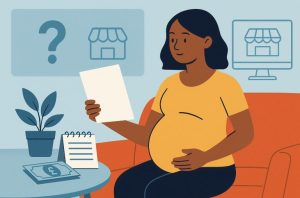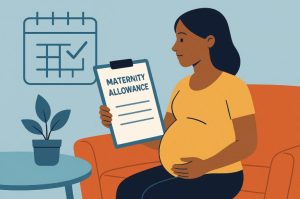Navigating pregnancy is life-changing, and for many new mothers in the UK, understanding maternity support can feel overwhelming. When you’re not eligible for Statutory Maternity Pay (SMP), the alternative, DWP Maternity Allowance, becomes essential.
It’s a government-backed benefit designed to provide financial stability during your maternity leave, especially if you’re self-employed, recently left a job, or helping run a family business.
This guide aims to explain everything you need to know about DWP Maternity Allowance 2025. From who qualifies and how much you’ll get, to how and when to apply, the goal is to help you understand your options clearly and confidently.
All the information provided here has been sourced from official government resources and current guidance for 2025, ensuring accuracy and reliability.
Let’s break it all down in the simplest way possible so you can make the right decisions for your family’s future.
What Is the DWP Maternity Allowance 2025?

Maternity Allowance 2025 is a payment made by the Department for Work and Pensions (DWP) to support expectant mothers who do not qualify for Statutory Maternity Pay from an employer.
This typically includes women who are self-employed, recently employed but not long enough for SMP, or involved in unpaid work for a spouse or civil partner’s business.
It is paid every four weeks or fortnightly directly into a bank account. The allowance aims to offer financial support to women during their maternity leave to help them meet daily living costs while they take time off to care for their newborn.
One of the most common reasons women claim Maternity Allowance is due to gaps in employment history or self-employment, which exclude them from employer-based maternity schemes.
The amount you receive can vary depending on your working history and earnings. For 2025, eligible mothers may receive up to £184.03 per week, or 90% of their average weekly earnings, whichever is lower. This benefit is paid for a maximum of 39 weeks, although shorter terms may apply depending on eligibility and contribution history.
Unlike Statutory Maternity Pay, which is handled by employers, Maternity Allowance is administered by the DWP. You’ll need to apply through the proper channels, usually with documentation such as your MATB1 certificate, payslips, or proof of income, and the MA1 claim form.
Understanding who qualifies and how this benefit works is essential if you’re planning maternity leave and suspect that SMP might not be available through your employer.
Who Is Eligible for Maternity Allowance in 2025?
Eligibility for DWP Maternity Allowance 2025 is primarily based on recent work history and earnings rather than current employment status. You do not need to be employed at the time of claiming, but you must meet certain conditions during a test period.
The test period is the 66 weeks before your baby’s due week. You must have worked in at least 26 of those 66 weeks. The work does not have to be consecutive and can include full-time, part-time, agency work, or self-employment.
In addition to the work requirement, your earnings must have averaged at least £30 a week for 13 of those 26 weeks. This applies regardless of whether the weeks were consecutive. It’s important to keep records of your income, especially if you’re self-employed, as this will determine the amount you’re eligible for.
If you’ve helped your spouse or civil partner run a business, you may also qualify even if you weren’t officially employed. However, this route typically provides a lower weekly allowance and for a shorter period, up to 14 weeks instead of 39.
Employment Types That May Qualify
- Self-employed workers registered with HMRC
- Individuals who’ve recently changed jobs or ended employment
- Workers with multiple short-term contracts
- Women assisting in their partner’s business
If you’re self-employed and haven’t paid enough National Insurance contributions, you may not be eligible for the full rate but can make additional payments to qualify.
Basic Eligibility Overview
| Requirement | Condition |
| Work History | 26 weeks in the 66-week test period |
| Minimum Earnings | At least £30/week for 13 weeks |
| Employment Type | Employed, self-employed, business helper |
| Benefit Duration | Up to 39 weeks (14 for helpers) |
What’s the Difference Between Statutory Maternity Pay and DWP Maternity Allowance 2025?

Many expectant mothers in the UK are unsure whether they will receive Statutory Maternity Pay or Maternity Allowance. Both provide maternity income, but they differ in source, eligibility, and payment structures.
Statutory Maternity Pay is paid by employers to their eligible employees. To qualify, you must have been employed continuously for at least 26 weeks by the same employer into the 15th week before your due date and earn at least the lower earnings limit.
In contrast, Maternity Allowance is paid by the DWP and is available to those who do not qualify for SMP. This includes self-employed individuals, women who have recently left employment, or those with multiple or temporary jobs.
SMP typically provides 90% of average weekly earnings for the first six weeks and a set weekly rate thereafter. Maternity Allowance offers a flat rate or 90% of earnings, up to a maximum amount, over the full 39-week period, depending on your earnings.
Understanding which one applies to you can help you prepare the right documents and plan financially.
How Much Will You Receive Through Maternity Allowance in 2025?
The amount of Maternity Allowance you can receive in 2025 depends on your earnings and work history. The standard rate for eligible applicants is £184.03 per week or 90% of your average weekly earnings, whichever is lower.
If you have made sufficient Class 2 National Insurance contributions and meet all eligibility requirements, you are likely to receive the full amount for up to 39 weeks. Those who haven’t paid enough contributions or fall into certain employment scenarios may receive a reduced amount and for a shorter duration, usually 14 weeks.
Payment is typically made every two or four weeks directly into your chosen account. It’s non-taxable and doesn’t affect other benefits like Child Benefit. However, it may impact Universal Credit, so checking with your work coach or benefits advisor is recommended.
When Payment Begins?
Payments can start as early as 11 weeks before your baby is due and will continue during your maternity leave period. If you return to work earlier than planned, your payments may stop or adjust accordingly.
Weekly Payment Breakdown
| Category | Weekly Payment | Duration |
| Self-Employed | £184.03 max | Up to 39 weeks |
| Recently Employed | £184.03 max | Up to 39 weeks |
| Business Helpers | Reduced Rate | Up to 14 weeks |
Can You Get Maternity Allowance If You’re Self-Employed?

Yes, Maternity Allowance is particularly beneficial for self-employed individuals, especially those not eligible for Statutory Maternity Pay. If you’re self-employed and registered with HMRC, you may claim the full rate of Maternity Allowance as long as you’ve paid enough Class 2 National Insurance contributions.
You must have worked for 26 weeks in the 66 weeks before your due week and earned at least £30 in 13 of those weeks. If you haven’t paid enough Class 2 NI contributions, you may receive a lower rate of Maternity Allowance, but you may be able to top up your contributions to qualify for the higher rate.
Self-employed mothers must also provide evidence of their work and income, such as invoices, receipts, or tax returns. If you work as a freelancer, gig worker, or in a non-traditional business model, ensure you keep detailed records to support your application.
This category of applicant often benefits most from Maternity Allowance, as it serves as a vital financial support during time away from work without a traditional employer framework.
How Do You Apply for DWP Maternity Allowance 2025?
Applying for Maternity Allowance in 2025 involves a straightforward but important process. The primary form is the MA1, which is available to print and fill out. You’ll also need to gather several documents to support your application.
Step-by-Step Application Process
1. Obtain the MA1 claim form from GOV.UK.
2. Fill it in with your personal, employment, and financial details.
3. Collect supporting documents, such as:
- Your MATB1 certificate (provided by a midwife or GP)
- Payslips or income statements
- Proof of Class 2 NI contributions (if self-employed)
4. Send your completed form and documents to the address on the form.
5. Await confirmation from DWP. If more information is needed, they will contact you.
Required Documents Checklist
| Document | Purpose |
| MATB1 Certificate | Proof of pregnancy and due date |
| MA1 Form | Primary application document |
| Payslips or Income Proof | Employment/self-employment |
| Proof of NI Contributions | For self-employed eligibility |
When Should You Submit Your Maternity Allowance Application?

The earliest you can apply for the DWP Maternity Allowance 2025 is when you are 26 weeks pregnant. Your payments can begin 11 weeks before your due date, so applying early ensures there’s no delay in receiving support.
Ideally, you should submit your application as soon as you receive your MATB1 certificate, which is issued around the 20-week mark. Submitting early also gives time to correct any errors or supply missing documents without affecting your start date.
Late applications are accepted, but may impact your backdated entitlement. If your baby arrives early and your application hasn’t been processed, payments will still be issued from the start date, but delays may occur.
Ensure you keep a copy of all forms and postal receipts when sending in your application, as these can help track or prove submission dates.
What Happens If Your Circumstances Change During Your Claim?
It’s important to report any changes in your circumstances to the DWP while receiving Maternity Allowance. These changes can affect your eligibility or the amount you receive.
Changes that must be reported include:
- Returning to work earlier than planned
- Changes in income or self-employment status
- Moving to a new address or bank account
- Becoming eligible for Statutory Maternity Pay through new employment
Failing to report changes could result in overpayment, which you may be required to repay later. You can report changes using the appropriate forms or by contacting DWP directly.
Keeping the DWP informed ensures your benefit continues smoothly and avoids complications during audits or checks.
Can You Work While Receiving DWP Maternity Allowance 2025?
Yes, but with limitations. Mothers can work up to 10 days during their Maternity Allowance period without losing benefits. These are called Keeping In Touch (KIT) days.
These days are designed to help you stay connected with your business or employer without fully returning to work. Any work beyond these 10 days could stop your payments, so it’s important to track them carefully.
If you’re self-employed, the same rules apply. The DWP may assess your work to ensure it’s within acceptable limits. You do not have to use all 10 days, but if you exceed them, you must inform the DWP, and payments may be affected.
This flexibility is especially helpful for women running small businesses who need occasional involvement in operations.
How Does Maternity Allowance Support Compare to Other Parental Benefits in the UK?

Maternity Allowance is just one part of the UK’s parental support system. Depending on your employment status and household income, you may also be eligible for:
- Statutory Maternity Pay (SMP)
- Shared Parental Leave
- Universal Credit
- Child Benefit
Maternity Allowance is a standalone benefit and cannot be claimed simultaneously with SMP. However, it may overlap with other benefits such as Universal Credit, although this might affect your total entitlement.
It’s important to check your overall benefits situation with an advisor, especially if you receive multiple forms of support. Understanding the full spectrum of available benefits ensures you don’t miss out on help you’re entitled to.
Conclusion
DWP Maternity Allowance 2025 offers crucial financial support to new and expectant mothers who may not qualify for employer-based maternity schemes. Whether you’re self-employed, between jobs, or helping run a family business, this benefit ensures you have a financial safety net during maternity leave.
Understanding eligibility, how much you could receive, when to apply, and what documents you’ll need can significantly ease the process. As with any benefit, staying informed and reporting changes is vital to ensure uninterrupted payments.
Taking time to plan your maternity leave with the right financial support in place can help you focus on what matters most, bonding with your new baby and taking care of your wellbeing.
FAQs
What is the maximum Maternity Allowance I can receive in 2025?
The maximum you can receive is £184.03 per week or 90% of your average weekly earnings, whichever is lower, for up to 39 weeks.
Can I apply for Maternity Allowance online?
No, the MA1 form must be printed, filled in by hand, and posted with your documents.
What if I don’t have enough NI contributions?
You may receive a lower rate or a shorter payment term, especially if self-employed. You can sometimes top up contributions.
Is Maternity Allowance taxable?
No, Maternity Allowance is not subject to income tax.
Can I receive Universal Credit and Maternity Allowance?
Yes, but your Maternity Allowance may reduce your Universal Credit payments.
Can I still qualify if I worked irregular jobs?
Yes, as long as you worked at least 26 weeks in the 66-week test period and earned £30 in 13 of those weeks.
Do I need to stop working completely to receive Maternity Allowance?
Not entirely. You’re allowed up to 10 Keeping In Touch (KIT) days without affecting your payments.









